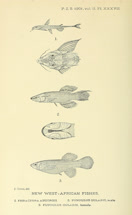|
|
Proceedings of the London Zoological Society 1901, P623; Plate 37, Figs. 2 and 3.
7. Descriptions of two new Fishes discovered by Dr. W. J. Ansorge in Southern Nigeria.
By Gr. A. Boulenger, F.R.S. [Received November 15, 190].] Fundulus gularis (Plate XXXYII. figs. 2 & 3.) Depth of body equal to, or a little less than, length of head, 3 1/2 to 4 times in total length. Snout as long as eye; lower jaw but feebly projecting beyond the upper; diameter of eye 3 3/4 to 4 times in length of head, twice in interorbital width. Dorsal 15-16, originating at nearly equal distance from the head and from the base of the caudal, longest rays about 2/3 length of head in females, 2/3 to 3/4 in males. Anal 16-18, opposed to dorsal, the rays about as long as those of the latter. Pectoral nearly 3/4 length of head, in males reaching beyond base of ventral, latter very small, with 6 rays. Caudal rounded, 3/4 or 4/5 length of head; one of the upper rays may be produced in the males. Caudal peduncle a little longer than deep. 30 or 31 scales in a longitudinal series, 12 or 13 in a transverse series; a series of pits represents the lateral line. Pale olive-brown above, white below; females uniform, or with a few reddish-brown dots on the dorsal and on the base of the anal. Males with a purple band on each side of the head, passing round to the other side over the lower jaw, and a median band of the same colour behind the chin, on the branchiostegal membrane; small carmine-red spots or vermiculations on the side of the head behind the eye, and often small spots of the same colour on the body; a streak or a series, of spots of crimson along the dorsal and anal and usually two, converging behind, on the caudal, the latter fin being grey between the streaks and pure white outside them; lower border of pectoral sometimes crimson. Total length 63 millim. No difference in size between the sexes. Numerous specimens were obtained in September 1901 at Agberi in shallow creeks and flooded yam-plantations. This species is most nearly related to F. sjoestcdti Lonnberg, from Camaroon, which has 17 or 18 rays to the dorsal fin, 35 scales, in the lateral line, and the posterior dorsal and anal rays much produced and filamentous in the males. The rudimentary pseudobranchiae, which exist in the East-African F. orthonotus Peters and F. guentheri Pfeff., and on which Peters's genus Nothobranchius is founded, are not to be found in F. gularis. Fig. 1 Phractura ansorgii, with enlarged upper view of head, p. 623. 2. Fundulus gularis, male, with enlarged lower view of head, p. 623. 3. Ditto, female.
|

